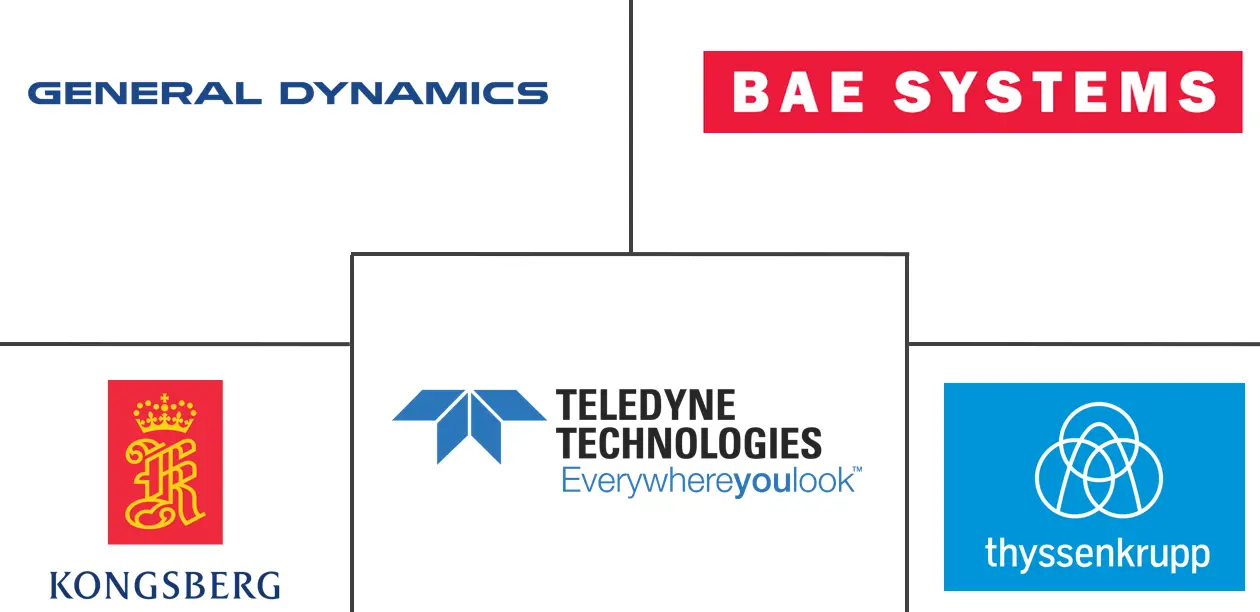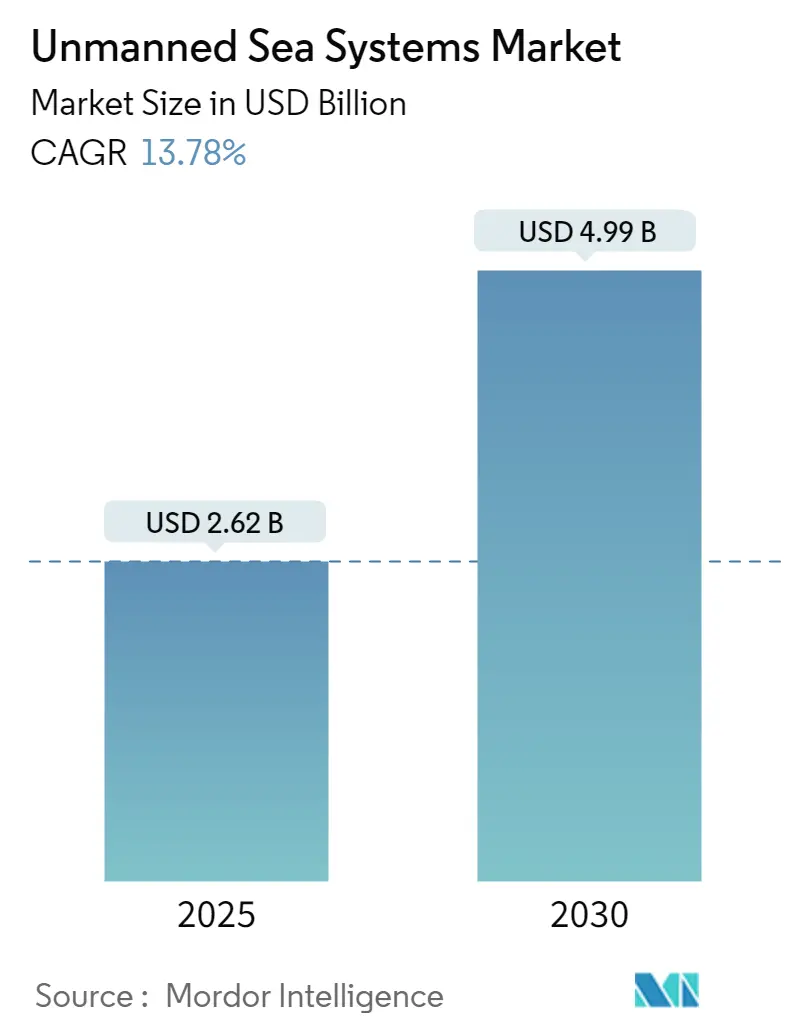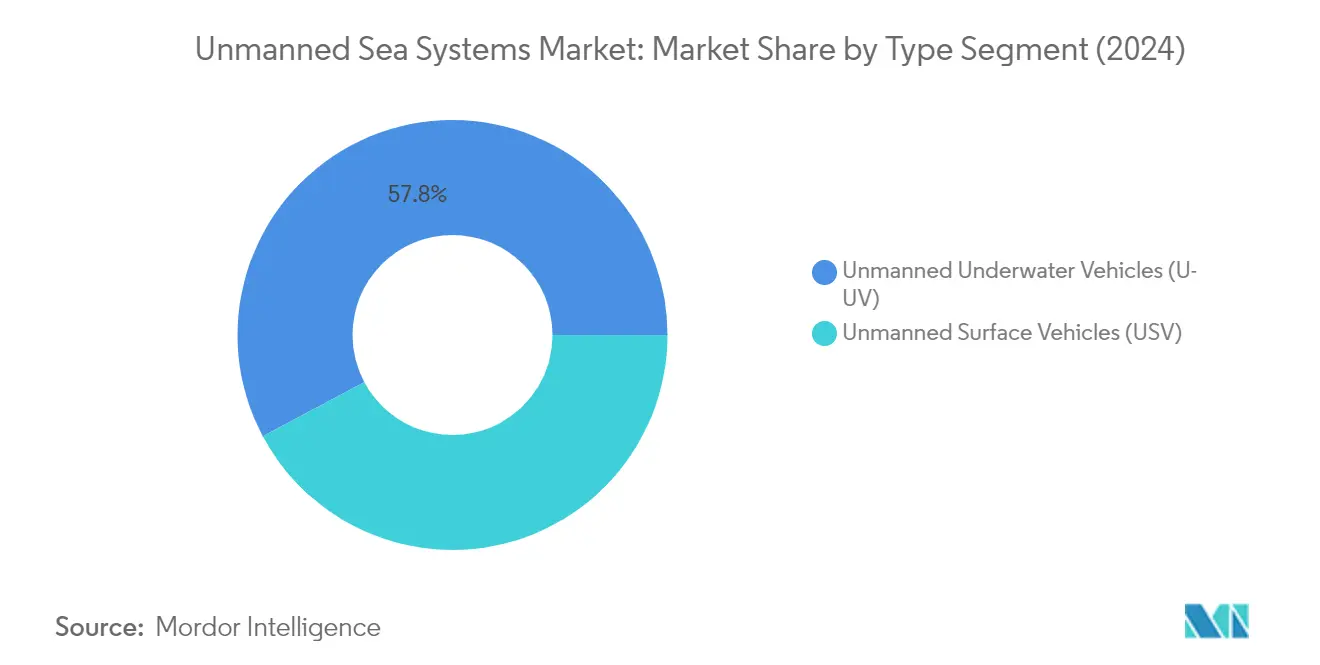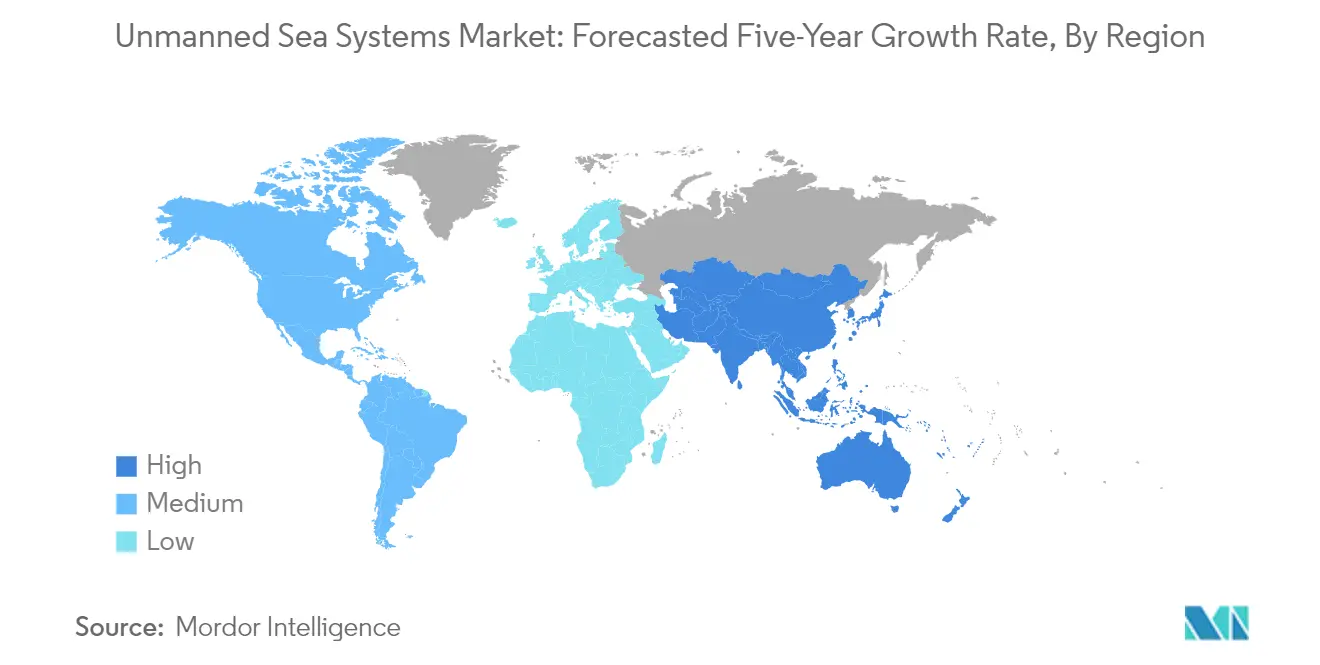Unmanned Sea System Market Analysis
The Unmanned Sea Systems Market size is estimated at USD 2.62 billion in 2025, and is expected to reach USD 4.99 billion by 2030, at a CAGR of 13.78% during the forecast period (2025-2030).
The unmanned sea systems market is experiencing significant transformation amid rising global defense expenditures and maritime security concerns. The United States, maintaining its position as the world's largest military spender, allocated USD 800.67 billion to defense in 2021, representing approximately 3% of global military spending. This substantial investment has catalyzed the development of sophisticated autonomous marine systems, with several nations following suit in modernizing their maritime capabilities. The integration of artificial intelligence and advanced sensor technologies has become increasingly prevalent, enabling enhanced operational capabilities in challenging maritime environments.
Technological innovation continues to reshape the industry landscape, with significant breakthroughs in autonomous navigation and AI-driven operations. In June 2022, China unveiled the world's first AI-operated unmanned ship, Zhu Hai Yun, featuring the Intelligent Mobile Ocean Stereo Observing system capable of coordinating various unmanned drones, ships, and submersibles. This development represents a significant milestone in autonomous maritime operations, demonstrating the growing sophistication of unmanned maritime systems. The industry has witnessed increased focus on developing multi-purpose platforms that can operate effectively in both military and commercial applications.
The commercial sector has emerged as a significant growth driver, with applications expanding beyond traditional military uses. In December 2022, the Canadian Department of National Defense contracted Kraken Robotics to deliver mine-hunting drones, highlighting the growing intersection of military and commercial technologies. The adoption of maritime autonomous systems in oceanographic research, hydrographic surveys, and offshore energy operations has created new market opportunities. Industry stakeholders are increasingly focusing on developing systems that can operate autonomously for extended periods, particularly in challenging deep-sea environments.
The industry is witnessing a shift toward standardization and improved interoperability among different systems. Major industry players are investing in research and development to address key technological challenges, particularly in underwater communications and autonomous decision-making capabilities. The focus has expanded to include the development of zero-emission propulsion systems, aligning with global sustainability goals. Recent developments in optical, acoustic, and electromagnetic communication modes are enhancing the operational capabilities of unmanned vessels, enabling more effective long-range operations and improved data transmission capabilities. The global underwater communication market size is also seeing advancements, further supporting the growth of unmanned maritime systems.
Unmanned Sea System Market Trends
Increasing Military Focus Towards the Development of Unmanned Sea Systems
Several nations are making substantial investments in autonomous and semi-autonomous naval platforms to enhance their maritime capabilities. The United States Navy has demonstrated this commitment through its FY2023 budget, allocating $549.3 million for research and development of large unmanned maritime systems, including Large Unmanned Surface Vehicles (LUSVs), Medium Unmanned Surface Vehicles (MUSVs), and Extra-Large Unmanned Undersea Vehicles (XLUUVs). These investments reflect a strategic shift toward developing larger unmanned vessels with autonomous capabilities that can operate for extended durations, conduct improved attack and surveillance operations in minefields, and track enemy submarines and UUVs with enhanced precision. The focus has expanded beyond basic remotely operated systems to sophisticated platforms capable of executing complex military missions while keeping personnel away from dangerous situations.
The global military landscape has witnessed significant advancements in unmanned maritime systems capabilities, with several countries launching innovative programs. China has made notable progress with its first large unmanned undersea vehicle, the HSU001, and is actively developing AI-driven unmanned submarines for surveillance, mine laying, and attack missions. Similarly, the Turkish defense industry has achieved a breakthrough with its first armored unmanned surface vessel (AUSV) and is now advancing into unmanned anti-submarine warfare vehicles. The French company Thales is pioneering anti-mine autonomous UUVs under their "Explainable and Trustable Artificial Intelligence" program, designed to enable informed decision-making in military applications. These developments highlight the growing emphasis on incorporating artificial intelligence and advanced autonomous capabilities in naval warfare systems.
Growing Adoption of Unmanned Vessels for Various Non-Military Applications
The commercial sector has witnessed a significant surge in the adoption of unmanned vessels across diverse applications, from oceanographic research to emergency response operations. These platforms have proven particularly valuable in hydrographic surveys, where they offer enhanced safety and efficiency compared to traditional manned operations. The versatility of unmanned vessels is demonstrated through their deployment in hydrology research, scientific exploration, emergency fire monitoring, and control in oil rigs. Recent technological advancements have enabled the development of sophisticated systems like Deep Trekker's Pivot ROV, launched in 2021, which features advanced capabilities including high power, enhanced stability, and improved control through lithium-ion battery technology, making it suitable for applications ranging from aquaculture to search and rescue operations.
The maritime industry is experiencing a transformative shift toward autonomous shipping solutions, with significant developments in commercial applications. In Japan, approximately 40 shipping companies are working toward implementing remote-control vessels in Japanese waters by 2025, utilizing satellites and 5G networks for ship-to-shore communication and AI for route optimization. This trend is further exemplified by major industry developments such as Oceaneering International's multi-year service contract with Petrobras in 2022, which encompasses the provision of advanced ROV services and survey equipment for offshore operations. These unmanned surface vehicle market solutions are increasingly being equipped with sophisticated features such as wave energy propulsion systems and solar cells, enabling months of maritime autonomy and demonstrating their potential to revolutionize traditional maritime operations while improving operational efficiency and safety.
Segment Analysis: Type
Unmanned Underwater Vehicles (UUV) Segment in Unmanned Sea Systems Market
The unmanned underwater vehicles market segment continues to dominate the global unmanned sea system market, commanding approximately 58% of the total market share in 2024. This significant market position is primarily driven by the segment's extensive application in military operations, particularly in mine countermeasures, anti-submarine warfare, and surveillance missions. The increasing adoption of UUVs by naval forces worldwide for intelligence gathering, underwater mapping, and maritime security operations has further strengthened this segment's market leadership. Additionally, the growing utilization of UUVs in commercial applications, including offshore oil and gas exploration, marine research, and underwater infrastructure inspection, has contributed to its market dominance. The segment's robust performance is also supported by ongoing technological advancements in autonomous navigation, sensor capabilities, and underwater communication systems.
Unmanned Surface Vehicles (USV) Segment in Unmanned Sea Systems Market
The unmanned surface vehicle market segment is experiencing remarkable growth in the unmanned sea systems market, driven by increasing adoption in both military and commercial applications. The segment's growth is fueled by the rising demand for autonomous vessels in maritime surveillance, coastal patrol, and environmental monitoring operations. USVs are gaining significant traction due to their ability to operate in challenging weather conditions and perform extended missions without human intervention. The integration of advanced technologies such as artificial intelligence, machine learning, and sophisticated sensor systems has enhanced the capabilities of USVs, making them increasingly attractive for various applications, including oceanographic research, hydrographic surveys, and maritime security operations. Furthermore, the development of larger autonomous vessels for commercial shipping applications and the increasing focus on reducing operational costs and human risk in maritime operations are expected to drive the segment's growth trajectory.
Segment Analysis: By Capability
Autonomous Vehicles Segment in Unmanned Sea Systems Market
The autonomous marine systems segment has established itself as the dominant force in the unmanned sea systems market, commanding approximately 55% of the market share in 2024. This significant market position is attributed to the increasing adoption of autonomous technologies in naval operations and maritime surveillance. The segment's growth is driven by major naval forces worldwide investing in autonomous underwater vehicles (AUVs) and autonomous surface vessels (ASVs) for various applications, including intelligence gathering, surveillance, and reconnaissance missions. These autonomous systems offer enhanced operational capabilities while reducing human risk exposure in challenging maritime environments. The integration of advanced technologies such as artificial intelligence and machine learning has further strengthened the segment's market position, enabling more sophisticated autonomous navigation and decision-making capabilities.
Remotely Operated Vehicles Segment in Unmanned Sea Systems Market
The Remotely Operated Vehicles (ROV) segment is experiencing remarkable growth in the unmanned maritime systems, emerging as the fastest-growing segment during the forecast period 2024-2029. This impressive growth trajectory is primarily driven by the expanding applications of ROVs in both commercial and military sectors. The segment's growth is fueled by increasing demand for underwater inspection, maintenance, and repair operations in the offshore energy sector. ROVs are becoming increasingly sophisticated with enhanced data collection capabilities about underwater subsea structures and geological formations. The integration of advanced sensors, high-definition cameras, and precise manipulation systems has made ROVs indispensable tools for complex underwater operations. Furthermore, the growing focus on deep-sea exploration and underwater infrastructure maintenance has created new opportunities for ROV deployment, supporting the segment's rapid expansion.
Unmanned Sea Systems Market Geography Segment Analysis
Unmanned Sea Systems Market in North America
North America represents a dominant force in the unmanned sea systems market, driven by substantial military expenditure and mature commercial sectors. The region's market is primarily shaped by the United States and Canada, with both countries demonstrating significant investments in naval defense capabilities and autonomous maritime technologies. The presence of major defense contractors and continuous technological innovations in autonomous underwater vehicles (UUVs) and the unmanned surface vehicle (USV) market has strengthened the region's position in the global market.
Unmanned Sea Systems Market in the United States
The United States maintains its position as the largest market for the unmanned sea systems market in North America, commanding approximately 75% of the regional market share in 2024. The country's dominance is attributed to its extensive naval modernization programs and substantial defense budget allocations. The U.S. Navy's strategic focus on developing and procuring various types of unmanned vehicles, including Large Unmanned Surface Vehicles (LUSVs), Medium Unmanned Surface Vehicles (MUSVs), and Extra-Large Unmanned Undersea Vehicles (XLUUVs), demonstrates its commitment to expanding autonomous capabilities. The Navy's comprehensive approach to integrating unmanned systems into its fleet architecture, coupled with robust research and development initiatives, continues to drive market growth.
Unmanned Sea Systems Market in Canada
Canada emerges as a rapidly growing market in North America, with a projected growth rate of approximately 16% from 2024 to 2029. The country's extensive coastal areas and increasing focus on maritime surveillance have driven the adoption of the unmanned sea systems market. Canada's government actively promotes domestic research and development in unmanned maritime technologies, fostering partnerships between international manufacturers and local companies. The country's strategic investments in mine-hunting drones and other autonomous naval capabilities, particularly for Arctic operations and coastal defense, highlight its commitment to advancing its maritime autonomous capabilities.
Unmanned Sea Systems Market in Europe
Europe is a significant player in the unmanned sea systems market, with the United Kingdom leading the region in terms of market size. The UK's strong defense sector and investment in naval technologies contribute to its prominent position. France and Germany also play crucial roles, with their respective defense industries focusing on the development of advanced unmanned underwater vehicles (UUV) market and surface vessels. The region's commitment to enhancing naval capabilities is reflected in collaborative projects and partnerships across European nations.
Unmanned Sea Systems Market in Asia-Pacific
The Asia-Pacific region is experiencing rapid growth in the unmanned sea systems market, with China leading in market size. The region's growth is fueled by increasing defense budgets and a focus on modernizing naval forces. India, with the fastest-growing market, is investing heavily in autonomous maritime technologies to bolster its naval capabilities. Japan's technological advancements and strategic initiatives further enhance the region's market potential.
Unmanned Sea Systems Market in Latin America
Latin America, led by Brazil, is an emerging market for the unmanned sea systems market. Brazil's significant market share is supported by its investment in naval defense and autonomous technologies. Mexico, as the fastest-growing market in the region, is focusing on enhancing its maritime surveillance and defense capabilities through the adoption of unmanned systems.
Unmanned Sea Systems Market in Middle East & Africa
The Middle East & Africa region is witnessing substantial growth in the unmanned sea systems market, with the United Arab Emirates leading in both market size and growth rate. The UAE's strategic investments in autonomous maritime technologies and defense capabilities underscore its commitment to advancing its naval forces. Saudi Arabia and Qatar are also investing in unmanned systems to enhance their maritime security and defense operations.
Global Naval Surface Vessels Market Size
The global naval surface vessels market size is expanding as nations worldwide invest in modernizing their naval fleets. The integration of unmanned systems into traditional naval architectures is a key trend driving growth. As countries seek to enhance their maritime capabilities, the demand for advanced surface vessels equipped with autonomous technologies is expected to rise.
Unmanned Sea System Industry Overview
Top Companies in Unmanned Sea Systems Market
The unmanned sea systems market features prominent players like Teledyne Technologies, General Dynamics, Lockheed Martin, Kongsberg Gruppen, and BAE Systems leading the innovation landscape. These companies are heavily investing in research and development to advance autonomous navigation capabilities, AI integration, and machine learning applications for underwater operations. The industry witnesses continuous product innovation focused on developing fuel-cell powered propulsion systems, enhanced communication networks, and multi-agent systems for coordinated operations. Strategic partnerships and collaborations with technology providers are becoming increasingly common to accelerate development cycles and maintain competitive advantage. Companies are expanding their geographical presence through local manufacturing facilities and service centers, particularly in regions with strong naval modernization programs. The focus on developing larger autonomous vessels for both commercial and military applications demonstrates the industry's commitment to pushing technological boundaries.
Consolidated Market with Strong Defense Focus
The unmanned maritime systems market is characterized by the dominance of large defense contractors and specialized maritime technology companies, with most major players having decades of experience in naval systems development. These established players benefit from long-standing relationships with military customers, extensive intellectual property portfolios, and sophisticated manufacturing capabilities. The market structure shows moderate consolidation, with the top players accounting for a significant share while maintaining healthy competition through differentiated technological capabilities and regional strengths. The industry has witnessed strategic acquisitions aimed at expanding product portfolios and gaining access to emerging technologies, particularly in autonomous navigation and underwater communication systems.
The competitive dynamics are shaped by the presence of both global defense conglomerates offering comprehensive naval solutions and specialized companies focusing exclusively on unmanned maritime systems. Regional players maintain strong positions in their domestic markets through close relationships with local defense establishments and understanding of specific operational requirements. The market sees regular collaboration between large system integrators and specialized technology providers, creating an ecosystem that promotes innovation while maintaining high barriers to entry for new competitors.
Innovation and Integration Drive Market Success
Success in the unmanned sea systems market increasingly depends on companies' ability to integrate advanced technologies while maintaining cost-effectiveness and operational reliability. Incumbent players must focus on developing modular architectures that allow for rapid integration of new capabilities while ensuring compatibility with existing naval systems. The ability to offer comprehensive solutions that include not just the platforms but also training, maintenance, and upgrade services is becoming crucial for maintaining market position. Companies need to demonstrate strong cybersecurity capabilities and robust supply chain management to address growing concerns about system vulnerability and component availability.
For emerging players and contenders, success lies in identifying and exploiting specific technological niches or regional market opportunities. The increasing focus on autonomous capabilities and environmental sustainability creates opportunities for specialized technology providers to gain market share through innovation in specific subsystems or capabilities. Companies must navigate complex regulatory environments, particularly regarding autonomous operations and environmental impact, while maintaining strong relationships with defense procurement agencies. The market's high dependence on government contracts and defense budgets makes diversification into commercial applications an important strategy for long-term sustainability. The underwater defense system market report highlights these trends, emphasizing the need for innovation in maritime autonomous systems to sustain competitive advantage.
Unmanned Sea System Market Leaders
-
General Dynamics Corporation
-
Teledyne Technologies Incorporated
-
Kongsberg Gruppen ASA
-
thyssenkrupp AG
-
BAE Systems plc
- *Disclaimer: Major Players sorted in no particular order
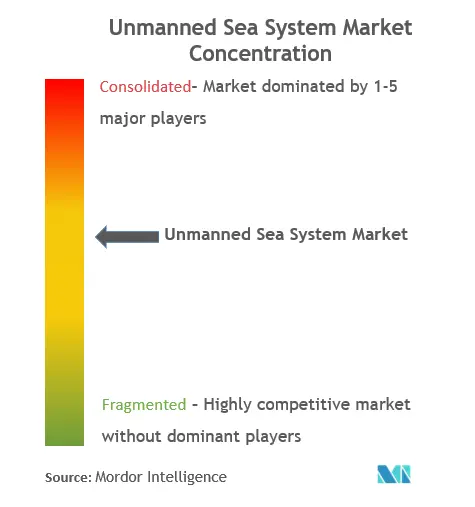
Unmanned Sea System Market News
- October 2023: The Naval Sea Systems Command, Washington, DC, signed a modification contract with Lockheed Martin Corporation to provide engineering support for Extra Large Unmanned Undersea Vehicle (UUV). The value of the contract was USD 11 million, and it will be completed by September 2024.
- September 2023: HII received a FAR-based contract from the US Navy for USD 19 million with a ceiling of USD 347 million to begin shipments of the REMUS 300 to PMS 408 by September 2024, with ongoing technology advancements and deliveries through 2028.
Unmanned Sea System Market Report - Table of Contents
1. INTRODUCTION
- 1.1 Study Assumptions
- 1.2 Scope of the Study
2. RESEARCH METHODOLOGY
3. EXECUTIVE SUMMARY
4. MARKET DYNAMICS
- 4.1 Market Overview
- 4.2 Market Drivers
- 4.3 Market Restraints
-
4.4 Porter's Five Forces Analysis
- 4.4.1 Bargaining Power of Buyers/Consumers
- 4.4.2 Bargaining Power of Suppliers
- 4.4.3 Threat of New Entrants
- 4.4.4 Threat of Substitute Products
- 4.4.5 Intensity of Competitive Rivalry
5. MARKET SEGMENTATION
-
5.1 Type
- 5.1.1 Unmanned Underwater Vehicles (UUV)
- 5.1.2 Unmanned Surface Vehicles (USV)
-
5.2 Capability
- 5.2.1 Remotely Operated Vehicles
- 5.2.2 Autonomous Vehicles
-
5.3 Application
- 5.3.1 Military
- 5.3.2 Commercial
- 5.3.3 Other Applications
-
5.4 Geography
- 5.4.1 North America
- 5.4.1.1 United States
- 5.4.1.2 Canada
- 5.4.2 Europe
- 5.4.2.1 United Kingdom
- 5.4.2.2 France
- 5.4.2.3 Germany
- 5.4.2.4 Russia
- 5.4.2.5 Rest of Europe
- 5.4.3 Asia-Pacific
- 5.4.3.1 China
- 5.4.3.2 Japan
- 5.4.3.3 India
- 5.4.3.4 South Korea
- 5.4.3.5 Rest of Asia-Pacific
- 5.4.4 Latin America
- 5.4.4.1 Brazil
- 5.4.4.2 Rest of Latin America
- 5.4.5 Middle East and Africa
- 5.4.5.1 United Arab Emirates
- 5.4.5.2 Saudi Arabia
- 5.4.5.3 South Africa
- 5.4.5.4 Rest of the Middle East and Africa
6. COMPETITIVE LANDSCAPE
- 6.1 Vendor Market Share
-
6.2 Company Profiles
- 6.2.1 thyssenkrupp AG
- 6.2.2 BAE Systems plc
- 6.2.3 General Dynamics Corporation
- 6.2.4 Lockheed Martin Corporation
- 6.2.5 Teledyne Technologies Incorporated
- 6.2.6 Kongsberg Gruppen ASA
- 6.2.7 Saab AB
- 6.2.8 L3Harris Technologies Inc.
- 6.2.9 Maritime Robotics AS
- 6.2.10 The Boeing Company
- 6.2.11 Groupe Gorge SA
- 6.2.12 Elbit Systems Ltd.
- *List Not Exhaustive
7. MARKET OPPORTUNITIES AND FUTURE TRENDS
Unmanned Sea System Industry Segmentation
Unmanned sea systems are naval assets that can operate without a human occupant onboard the vessel.
The unmanned sea systems market is segmented based on type, capability, and geography. By type, the market is segmented into unmanned underwater vehicles (UUVs) and unmanned surface vehicles (USVs). By capability, the market is divided into remotely operated vehicles and autonomous vehicles. By application, the market is segmented into military, commercial, and other applications. Others include scientific and oceanographic research applications. The report also covers the market sizes and forecasts for the unmanned sea system market in major countries across different regions. For each segment, the market size is provided in terms of value (USD).
| Type | Unmanned Underwater Vehicles (UUV) | ||
| Unmanned Surface Vehicles (USV) | |||
| Capability | Remotely Operated Vehicles | ||
| Autonomous Vehicles | |||
| Application | Military | ||
| Commercial | |||
| Other Applications | |||
| Geography | North America | United States | |
| Canada | |||
| Europe | United Kingdom | ||
| France | |||
| Germany | |||
| Russia | |||
| Rest of Europe | |||
| Asia-Pacific | China | ||
| Japan | |||
| India | |||
| South Korea | |||
| Rest of Asia-Pacific | |||
| Latin America | Brazil | ||
| Rest of Latin America | |||
| Middle East and Africa | United Arab Emirates | ||
| Saudi Arabia | |||
| South Africa | |||
| Rest of the Middle East and Africa | |||
Unmanned Sea System Market Research FAQs
How big is the Unmanned Sea Systems Market?
The Unmanned Sea Systems Market size is expected to reach USD 2.62 billion in 2025 and grow at a CAGR of 13.78% to reach USD 4.99 billion by 2030.
What is the current Unmanned Sea Systems Market size?
In 2025, the Unmanned Sea Systems Market size is expected to reach USD 2.62 billion.
Who are the key players in Unmanned Sea Systems Market?
General Dynamics Corporation, Teledyne Technologies Incorporated, Kongsberg Gruppen ASA, thyssenkrupp AG and BAE Systems plc are the major companies operating in the Unmanned Sea Systems Market.
Which is the fastest growing region in Unmanned Sea Systems Market?
Asia-Pacific is estimated to grow at the highest CAGR over the forecast period (2025-2030).
Which region has the biggest share in Unmanned Sea Systems Market?
In 2025, the North America accounts for the largest market share in Unmanned Sea Systems Market.
What years does this Unmanned Sea Systems Market cover, and what was the market size in 2024?
In 2024, the Unmanned Sea Systems Market size was estimated at USD 2.26 billion. The report covers the Unmanned Sea Systems Market historical market size for years: 2019, 2020, 2021, 2022, 2023 and 2024. The report also forecasts the Unmanned Sea Systems Market size for years: 2025, 2026, 2027, 2028, 2029 and 2030.
Our Best Selling Reports
Unmanned Sea Systems Market Research
Mordor Intelligence offers extensive expertise in analyzing the unmanned maritime systems sector. We provide comprehensive insights into autonomous marine systems and their evolving applications. Our detailed analysis covers the entire spectrum of unmanned sea systems, including both unmanned surface vehicles (USV) and unmanned underwater vehicles (UUV). The report examines crucial developments in global underwater communication technologies and submarine rescue systems. It also explores emerging trends in naval surface vessels, available as an easy-to-download report PDF.
Stakeholders benefit from our thorough assessment of maritime autonomous systems and their integration with underwater exploration robots. The report provides detailed revenue analysis of hydrographic survey equipment markets and explores emerging technologies in global underwater swarm warfare. Our research encompasses unmanned surface and underwater vessels market dynamics, offering strategic insights for manufacturers, investors, and end-users. The comprehensive forecast includes a detailed analysis of underwater defense systems and submarine rescue systems, supporting informed decision-making in this rapidly evolving sector.

